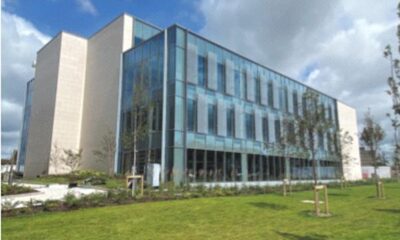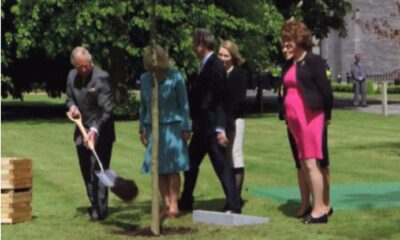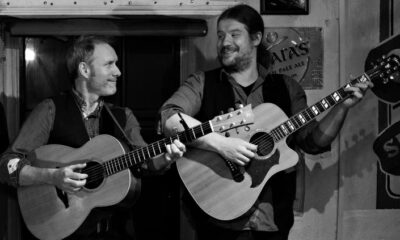News
Parents launch campaign to provide for brave Tomás

A dedicated and determined Galway couple are battling to raise funds to care for their five-year-old son, who was born prematurely and left with cerebral palsy following a series of harrowing complications at birth.
Little Tomás McLoughlin from Roscam lost his identical twin brother Seán at just 30 days of age, while he was left with no independent movement.
Because he has spastic quadriplegic cerebral palsy, he requires 24-hour care and requires extremely costly equipment to help live as independent a life as possible.
His parents Ann-Marie Duggan (from Renmore) and Shane McLoughlin (from Ballinasloe and originally Castlerea) have set up a campaign through Facebook called ‘Tomorrow for Tomás’, where they hope to raise funds for his care, as well as costly equipment such as a €20,000 powered wheelchair and a €3,500 car seat.
Ann-Marie had an uneventful pregnancy in 2009, until she discovered at 16 weeks that she was expecting identical twins – which made the pregnancy ‘high risk’. From then, the twins were struck with a series of traumatic events and complications.
On March 10, 2010 Ann-Marie wasn’t feeling well and went to University Hospital Galway to get checked out. She was advised that her waters had started to break, and was sent to the Coombe Hospital in Dublin, because there would be a full team in place there, while UHG had only one incubator available.
“It was just over 26 weeks, and we were told there was a 70% chance they wouldn’t survive. So we got the ambulance to the Coombe. I was admitted and after 11pm that night, I tried to turn in the bed and blood started flowing suddenly. The nurse got the Registrar, and heartbeats were being checked . . . it was like watching a scene from ‘ER’,” she says.
Her placenta had ruptured and she was later told that if she left Galway an hour later, she would have bled out and died.
Shane left the room at 11.15pm to let his wife get some rest – Seán was born at 11.23pm and Tomás at 11.25pm.
“My first interaction with them, they were in incubators – it was almost like they were in Ziplock sandwich bags. They were 2lb 3oz and 2lb 1oz,” he says. For Ann-Marie, the sound of the machines keeping her boys alive is something she will never forget.
Two days later, Tomás’ machine went “haywire” and he suffered extremely severe bleeding on both sides of the brain, which left him brain-damaged. A short time later, Seán also suffered a bleed, but it was not as severe as his younger brother’s.
“The doctor said Tomás would have cerebral palsy and will never walk or talk. We were broken-hearted. I ploughed on and was expressing milk to keep busy. I was racked with guilt, wondering if I did something wrong, if it was my fault.
“I was in the Coombe and saw babies being born 8lb and 9lbs who had to be weaned off drugs. I met a girl in the lift who was full-term and offered me a drink from her bottle of vodka. What did I do wrong?” she recalls.
Shane says: “It was all very surreal. But when you’re put in that situation, you just have to get on with it. There’s nothing else you can do.”
“Around 25/26 days, Tomás was having a bad night, then a good night,” says Ann-Marie. “We were told he was not going to survive, then by the following morning, he would have rallied again.
“On day 27, they were still in ICU and the nurse asked if I wanted to hold Seán in ‘kangaroo care’ (which allows skin-to-skin contact). I had half-an-hour holding him. We got to hold him twice each.
“At 4am, we got a call to say Seán was very, very sick, that he had NEC (Necrotising Enterocolitis, where the intestine perforates and allows waste products into the bloodstream). That evening, we were half-way through a meal, even though we couldn’t eat, and were told they needed to move Seán to Crumlin Children’s Hospital.
“We were told that a perforation of the bowel could be operated on, but a full collapse couldn’t (the latter would inevitably result in death). We didn’t know which it was. Ten minutes in, the surgeon’s hand came out. I’ll never forget Shane’s roaring and crying. There was nothing they could do. He was kept on life support back in the Coombe and close family came up to see him.
“We wanted to wait until after midnight so he would be 30 days old [before switching off life support]. It’s a very cold thing. You’d never want anyone to go through it,” says Ann-Marie.
He was subsequently buried in Rinville, Oranmore, to be close to the sea. During the burial, the couple had to rush to Crumlin, where Tomás had had an operation for NEC due to a perforated bowel. His recovery was excruciatingly slow – he was being given 0.1ml of sterile water per day, gradually increasing to 0.5ml after a week.
Shane says: “That was a huge step for Tomás; waiting for small incremental changes meant so much psychologically to us.”
Despite doctors saying Tomás would never walk or talk, Ann-Marie was driven by a devoted determination, and researched early intervention.
She purchased black and white pictures and book, laminated them and placed them on the incubator where Tomás would see them. After 105 days, the couple were able to leave the Coombe with their son.
Fortunately, Ann-Marie’s brother Seán is a Redemptorist priest, and the Order was able to accommodate the couple at the Marianella Centre in Rathgar during their time in Dublin, for which they are eternally grateful.
“The Redemptorists couldn’t do enough for us, we had food each day, a bed, they even bought a secondhand couch, an armchair and TV. They did everything they could for us.
“Seán wasn’t even ordained a priest a year, so it really was a baptism of fire for him,” says Shane.
Despite the learning aids, the couple were concerned Tomás did not seem to be making good progress as he wasn’t meeting the milestones of movement, and wasn’t making huge sounds or talking. But that concern was short-lived.
“Now he’s just gone five, he can read Ladybird books and is a real chatterbox. You can’t shut him up now! I really think the early intervention made a huge difference. The flash cards, the black and white pictures, the DVDs, everything. We’re over the moon with the progress he’s made,” says Ann-Marie.
It is a remarkable improvement for a premature baby who lost his twin, and had also been through Grade 3 and 4 bleeds to his brain; gut drains; ileostomy (opening the stomach wall to remove waste); lung drains; chronic lung disease and retinopathy of prematurity (abnormal development of the retina).
Now, Tomás has very good cognitive skills, but relatively no independent movement. The specialised equipment he requires is exceptionally difficult to get through the HSE and can cost tens of thousands of euro to buy privately. For example, a powered wheelchair – which he is currently being trained by Enable Ireland to use with his head – will cost around €20,000.
A car seat that would normally cost around €300 will cost €3,500, or it does not meet insurance company requirements.
“Everything adds up. Almost all of the items or equipment or technology are beyond affordability for us. You will always need specific care and that costs money,” says his father.
“It is just the two of us caring for him and we are both working. We get twelve hours [support] per week from Enable Ireland, but will always need specific care, and that costs money. He needs one-on-one attention.
“So we’ve set up a campaign called ‘Tomorrow for Tomás’ to raise funds for all he’s going to require into his future. I was slow to ask people for help, I suppose that’s a matter of pride. But everything adds up and we do need help,” adds Shane.
Tomás is also being trained to use an ‘Eye Gaze’ system at the moment – ahead of starting school in Merlin Park in September. This is a system which tracks the eyes and moves a mouse pointer around the computer screen, while blinking and staring also activates the communication system.
However, if the HSE will not fund the system, it will cost the family €4,500. Otherwise Tomás will not be able to access the curriculum in school.
“The HSE won’t give a definite answer on anything. It could be six months before an application goes through, then another six before the manufacturer comes through. It’s extremely frustrating. We could be waiting another two years for a powered wheelchair. The system is wrong,” says Shane.
The couple have two other boys, Matthew (3) and Luke (16 months), who were both born perfectly healthy.
■ You can find out more by visiting ‘Tomorrow for Tomás’ on Facebook. Donations to the Tomorrow for Tomás’ fund can be made to AIB, Newcastle Road, Galway. BIC. AIBKIE2D. IBAN: IE97AIBK93743621817041
Connacht Tribune
West has lower cancer survival rates than rest

Significant state investment is required to address ‘shocking’ inequalities that leave cancer patients in the West at greater risk of succumbing to the disease.
A meeting of Regional Health Forum West heard that survival rates for breast, lung and colorectal cancers than the national average, and with the most deprived quintile of the population, the West’s residents faced poorer outcomes from a cancer diagnosis.
For breast cancer patients, the five-year survival rate was 80% in the West versus 85% nationally; for lung cancer patients it was 16.7% in the west against a 19.5% national survival rate; and in the West’s colorectal cancer patients, there was a 62.6% survival rate where the national average was 63.1%.
These startling statistics were provided in answer to a question from Ballinasloe-based Cllr Evelyn Parsons (Ind) who said it was yet another reminder that cancer treatment infrastructure in the West was in dire need of improvement.
“The situation is pretty stark. In the Western Regional Health Forum area, we have the highest incidence of deprivation and the highest health inequalities because of that – we have the highest incidences of cancer nationally because of that,” said Cllr Parsons, who is also a general practitioner.
In details provided by CEO of Saolta Health Care Group, which operates Galway’s hospitals, it was stated that a number of factors were impacting on patient outcomes.
Get the full story in this week’s Connacht Tribune, on sale in shops now, or you can download the digital edition from www.connachttribune.ie. You can also download our Connacht Tribune App from Apple’s App Store or get the Android Version from Google Play.
Connacht Tribune
Marathon Man plans to call a halt – but not before he hits 160 races
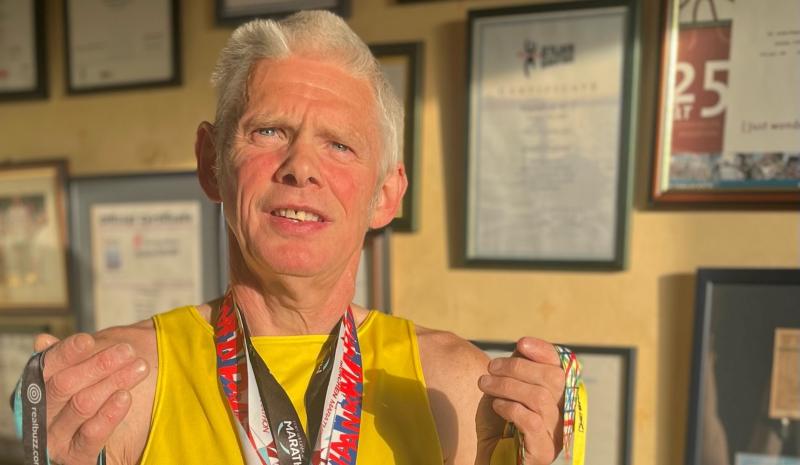
On the eve of completing his 150th marathon, an odyssey that has taken him across 53 countries, Loughrea’s Marathon Man has announced that he is planning to hang up his running shoes.
But not before Jarlath Fitzgerald completes another ten races, making it 160 marathons on the occasion of his 60th birthday.
“I want to draw the line in 2026. I turn 57 in October and when I reach 60 it’s the finishing line. The longer races are taking it out of me. I did 20 miles there two weeks ago and didn’t feel good. It’s getting harder,” he reveals.
“I’ve arthritis in both hips and there’s wear and tear in the knees.”
We speak as he is about to head out for a run before his shift in Supervalu Loughrea. Despite his physical complaints, he still clocks up 30 miles every second week and generally runs four days a week.
Jarlath receives injections to his left hip to keep the pain at bay while running on the road.
To give his joints a break, during the winter he runs cross country and often does a five-mile trek around Kylebrack Wood.
He is planning on running his 150th marathon in Cork on June 4, where a group of 20 made up of work colleagues, friends and running mates from Loughrea Athletics Club will join him.
Some are doing the 10k, others are doing the half marathon, but all will be there on the finishing line to cheer him on in the phenomenal achievement.
Get the full story in this week’s Connacht Tribune, on sale in shops now, or you can download the digital edition from www.connachttribune.ie. You can also download our Connacht Tribune App from Apple’s App Store or get the Android Version from Google Play.
CITY TRIBUNE
Galway ‘masterplan’ needed to tackle housing and transport crises
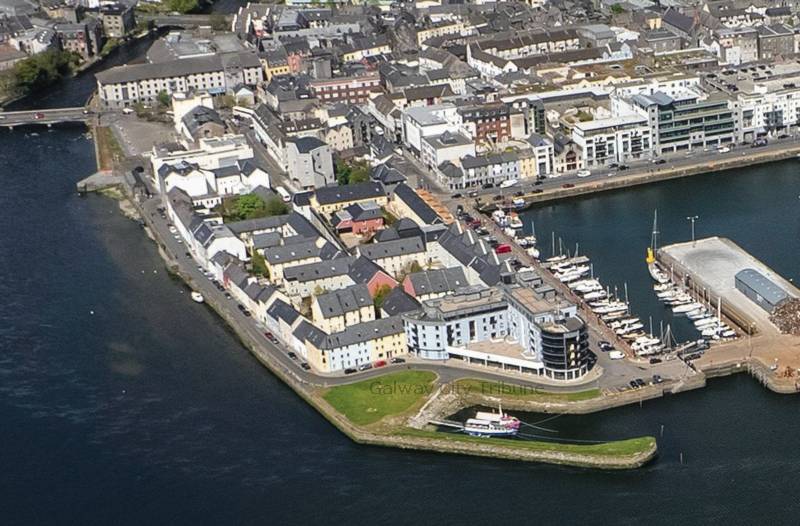
From the Galway City Tribune – An impassioned plea for a ‘masterplan’ that would guide Galway City into the future has been made in the Dáil. Galway West TD Catherine Connolly stated this week that there needed to be an all-inclusive approach with “vision and leadership” in order to build a sustainable city.
Deputy Connolly spoke at length at the crisis surrounding traffic and housing in Galway city and said that not all of the blame could be laid at the door of the local authority.
She said that her preference would be the provision of light rail as the main form of public transport, but that this would have to be driven by the government.
“I sat on the local council for 17 years and despaired at all of the solutions going down one road, metaphorically and literally. In 2005 we put Park & Ride into the development plan, but that has not been rolled out. A 2016 transport strategy was outdated at the time and still has not been updated.
“Due to the housing crisis in the city, a task force was set up in 2019. Not a single report or analysis has been published on the cause of the crisis,” added Deputy Connolly.
She then referred to a report from the Land Development Agency (LDA) that identified lands suitable for the provision of housing. But she said that two-thirds of these had significant problems and a large portion was in Merlin Park University Hospital which, she said, would never have housing built on it.
In response, Minister Simon Harris spoke of the continuing job investment in the city and also in higher education, which is his portfolio.
But turning his attention to traffic congestion, he accepted that there were “real issues” when it came to transport, mobility and accessibility around Galway.
“We share the view that we need a Park & Ride facility and I understand there are also Bus Connects plans.
“I also suggest that the City Council reflect on her comments. I am proud to be in a Government that is providing unparalleled levels of investment to local authorities and unparalleled opportunities for local authorities to draw down,” he said.
Then Minister Harris referred to the controversial Galway City Outer Ring Road which he said was “struck down by An Bord Pleanála”, despite a lot of energy having been put into that project.
However, Deputy Connolly picked up on this and pointed out that An Bord Pleanála did not say ‘No’ to the ring road.
“The High Court said ‘No’ to the ring road because An Bord Pleanála acknowledged it failed utterly to consider climate change and our climate change obligations.
“That tells us something about An Bord Pleanála and the management that submitted such a plan.”
In the end, Minister Harris agreed that there needed to be a masterplan for Galway City.
“I suggest it is for the local authority to come up with a vision and then work with the Government to try to fund and implement that.”


